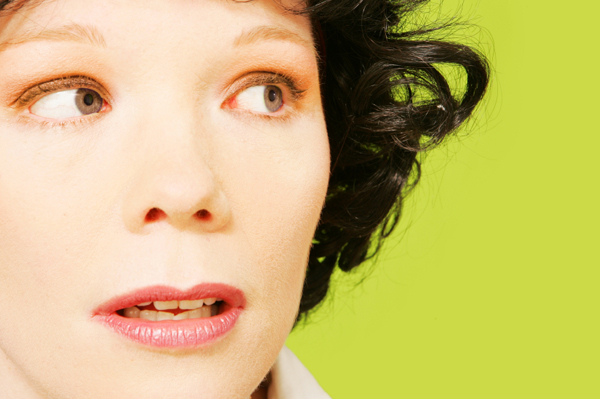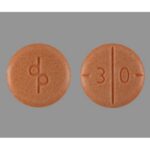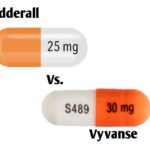How Long Does E 404 Adderall Pill Last?

E 404 Adderall is a brand of Amphetamine and Dextroamphetamine 30 mg supplied by Sandoz Pharmaceuticals Inc.. Amphetamine and dextroamphetamine combination like E 404 pill is used to treat attention-deficit hyperactivity disorder (ADHD) and narcolepsy (uncontrollable desire for sleep or sudden attacks of deep sleep). These two medicines belong to the group of medicines called central nervous system (CNS) stimulants.
E 404 pill works in the treatment of ADHD to increase attention and decrease restlessness in patients who are overactive, cannot concentrate, or are easily distracted. It is used as part of a total treatment program that also includes social, educational, and psychological therapy.
Even though E 404 Adderall pill is a prescription medication, it is often abused. In recent years, many young adults have abused the medication for its euphoric effects. A 2016 study published in The Journal of Clinical Psychiatry found that Adderall misuse is highest among adults aged 18 to 25, who primarily receive the medication from loved ones without a prescription.
From 2016 to 2017, the number of people age 12 and older who misused Adderall increased from 5.1 million to 5.2 million. Adderall and amphetamine abuse is on the rise. People who abuse Adderall often take someone else’s medication or buy it illegally. They may also take it in a way other than prescribed (by crushing, snorting, or injecting it) in an attempt to intensify the high. High school and college students may use the drug to improve their performance in school, and adults may take them to improve their memory or perform better at work. Misuse can lead to addiction, overdose, and significant adverse effects such as cardiovascular disease, unhealthy weight loss, and psychotic symptoms.
How long does E 404 Adderall pill last?
The therapeutic effects of an E 404 Adderall pill begins 45 to 60 minutes after use, with peak effects occurring two to three hours after ingestion. In total, the effects of E 404 pill can last four to six hours. The effects of this medication kick in within 30 to 60 minutes, and they can last up to 12 hours. The peak effects take place four to seven hours after use.
According to a report by the Food and Drug Administration, an immediate-release tablet of Amphetamine and Dextroamphetamine produces peak plasma concentrations about three hours after last use. A 2009 study published in the Journal Molecular Psychiatry showed that 20 milligrams of an extended-release capsule, can produce a maximum plasma concentration about six hours after ingestion.
What Are The Side Effects of E 404 Adderall?
Side effects of E 404 Adderall include:
• nervousness,
• restlessness,
• excitability,
• irritability,
• agitation,
• dizziness,
• headache,
• fear,
• anxiety,
• agitation,
• tremor,
• weakness,
• blurred vision,
• sleep problems (insomnia),
• dry mouth or unpleasant taste in the mouth,
• diarrhea,
• constipation,
• stomach pain,
• nausea,
• vomiting,
• fever,
• hair loss,
• loss of appetite,
• weight loss,
• loss of interest in sex,
• impotence,
• difficulty having an orgasm,
• increase blood pressure,
• increased heart rate, and
• heart palpitations.
What Drugs, Substances, or Supplements Interact with E 404 Adderall?
Adderall may interact with:
• heart or blood pressure medications,
• diuretics (water pills),
• cold or allergy medicines (antihistamines),
• acetazolamide,
• chlorpromazine,
• ethosuximide,
• haloperidol,
• lithium,
• meperidine,
• methenamine,
• phenytoin,
• phenobarbital,
• reserpine,
• ammonium chloride,
• ascorbic acid (vitamin C),
• potassium phosphate,
• antacids,
• sodium bicarbonate (Alka-Seltzer),
• potassium citrate,
• sodium citrate and citric acid,
• sodium citrate and potassium,
• stomach acid reducers, or
• antidepressants
Tell your doctor all medications and supplements you use.
Get emergency medical help if you have signs of an allergic reaction: hives; difficult breathing; swelling of your face, lips, tongue, or throat.
Call your doctor at once if you have:
• signs of heart problems–chest pain, trouble breathing, feeling like you might pass out;
• signs of psychosis–hallucinations (seeing or hearing things that are not real), new behavior problems, aggression, hostility, paranoia;
• signs of circulation problems–numbness, pain, cold feeling, unexplained wounds, or skin color changes (pale, red, or blue appearance) in your fingers or toes;
• a seizure (convulsions);
• muscle twitches (tics); or
• changes in your vision.
Seek medical attention right away if you have symptoms of serotonin syndrome, such as: agitation, hallucinations, fever, sweating, shivering, fast heart rate, muscle stiffness, twitching, loss of coordination, nausea, vomiting, or diarrhea.
Long-term use of stimulant medicine can affect growth in children. Tell your doctor if your child is not growing at a normal rate while using this medicine.
Common side effects may include:
• stomach pain, nausea, loss of appetite;
• weight loss;
• mood changes, feeling nervous or irritable;
• fast heart rate;
• headache, dizziness;
• sleep problems (insomnia); or
• dry mouth.
This is not a complete list of side effects and others may occur. Call your doctor for medical advice about side effects. You may report side effects to FDA at 1-800-FDA-1088.





